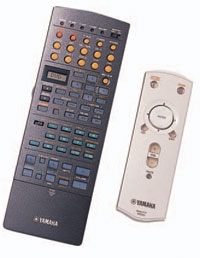Yamaha RX-Z9 THX Ultra2 Digital Surround Receiver Page 3
The receiver will have determined which speakers you have hooked up, which are installed out of phase (if any), and which are "large" or "small." The speaker distances will also have been measured and compensated for, and the speaker balances will have been optimized - even for the subwoofer. Compared with the usual manual procedure, YPAO is a breeze.
Besides automatically optimizing the usual setup parameters, YPAO adjusts frequency response through each of the attached speakers. The process involves ten bands of parametric equalization for each channel. This type of EQ is rarely used, even by professionals, because it's so tough to do right manually. But it's a cakewalk for the RX-Z9's digital processing.
To me, however, YPAO's equalization proved to be both just what the doctor ordered and too much of a good thing. It was successful in our listening room in taming a prominent midbass resonance and in smoothing the crossover-frequency region. Before/after measurements of that region showed a reduction of the response swing from around ±9 dB to only ±4 dB, a substantial improvement. Overall, the EQ very noticeably reduced midbass muddiness and enhanced the subwoofer's sonic blend with the main speakers.
| PLUSGenerally excellent automatic setup. Uniform bass management and speaker-distance compensation. i.Link (FireWire) audio inputs. Excellent onscreen menus. Video-format conversion facilities. Wide audio dynamic range. MINUSAutomatic EQ system might degrade tonal quality. Slight loss of resolution when video processing is activated. Very heavy and expensive. |
Menu selections let you allocate the parametric EQ resources to produce the flattest response over the entire range or to focus on flattening just the highs, midrange, or bass. The problem is that regardless of the type of equalization you select, there's always some effect on the entire region above the midbass. Because of this, the higher frequencies ended up being overemphasized on vocals and strings, at least in our room with our speakers.
While you can set YPAO to skip the EQ adjustments, I wish Yamaha had supplied a YPAO mode that placed all the parametric EQ resources at the service of smoothing the room-resonance and crossover-frequency range (that is, the lower frequencies) while letting the higher frequencies fall where the speakers dictate. That way the speakers' basic tonal qualities will be unchanged while their interaction with the room is improved.
Perhaps a firmware update, applied via computer through the receiver's RS-232C port (normally used for computer-controlled setup and operation by installers), could supply such a mode. I'd also like to see an easier way to reset YPAO equalization to completely neutral status - a simple menu selection would work. As is, it's a cumbersome procedure not covered in the manual.
The renowned sonic quality of Yamaha's Soundfield and Cinema DSP ambience processing, as well as those systems' seemingly infinite adjustability, were as much in evidence here as in previous Yamaha receivers I've tested. With 55 ambience-generation modes and 24 variations of Cinema DSP on call, if you want to spatially enhance your music and soundtracks, there's undoubtedly a mode (or a customized setting of a mode) to suit the program material. Yamaha recommends using two smaller Presence speakers placed outside and behind the front left and right speakers for the front ambience effects. This removes ambience from the main front speakers and prevents it from coloring the front image, allowing you to get the best combination of ambience and imaging.
 |
| The Yamaha RS-Z9 did a clean job of decoding the 6.1-channel soundtrack of Dirty Dancing. |
Certainly DVD movies played using the standard decoding functions sounded excellent, such as the 6.1-channel Dolby Digital EX soundtrack of Dirty Dancing. And every SACD and DVD-Audio disc I played through the i.Link inputs also sounded superb. Having those THX power reserves and low noise levels on hand was especially beneficial in the effortless reproduction of wide-dynamic-range classical material, such as the stunning Mahler series issued on SACD by the San Francisco Symphony Orchestra. The last few moments of the Sixth Symphony, featuring a sudden fortissimo chord, are all the more shocking when the preceding pianissimo phrase is cleanly reproduced with no added noise.
 The unusually versatile and capable RX-Z9 - definitely not your run-of-the-mill flagship receiver! - has dozens of other features we simply don't have space to discuss. If infinite tweaking of sound quality is your thing, it has enough going on to keep you busy for months. (Experimenting with multichannel speaker placement is much easier with YPAO on call.) If not, then the smooth, attractive onscreen menu system controlled by the elegant eight-button auxiliary remote control will actually simplify operation compared with the standard remote. Has the audio side of your audio/ video interest been hit by a case of the blahs lately? Yamaha's RX-Z9 may be the perfect prescription.
The unusually versatile and capable RX-Z9 - definitely not your run-of-the-mill flagship receiver! - has dozens of other features we simply don't have space to discuss. If infinite tweaking of sound quality is your thing, it has enough going on to keep you busy for months. (Experimenting with multichannel speaker placement is much easier with YPAO on call.) If not, then the smooth, attractive onscreen menu system controlled by the elegant eight-button auxiliary remote control will actually simplify operation compared with the standard remote. Has the audio side of your audio/ video interest been hit by a case of the blahs lately? Yamaha's RX-Z9 may be the perfect prescription.
- Log in or register to post comments




































































